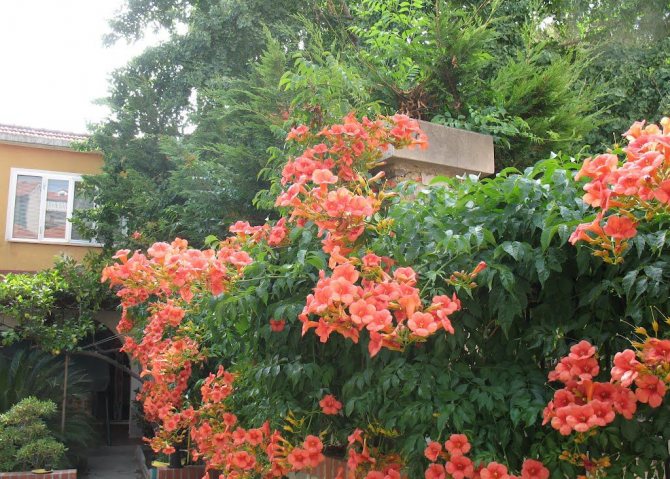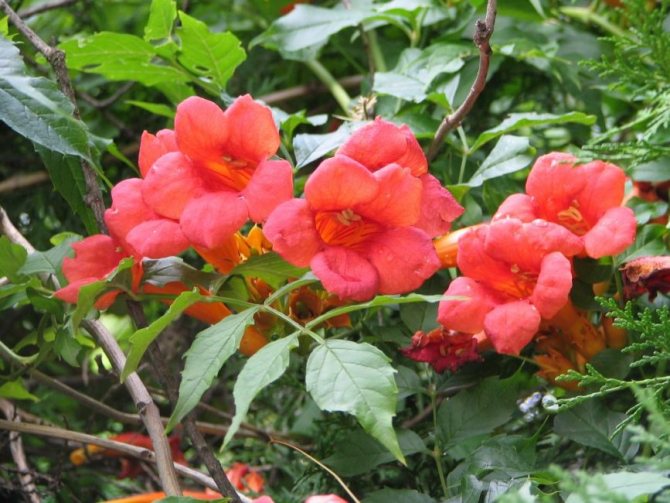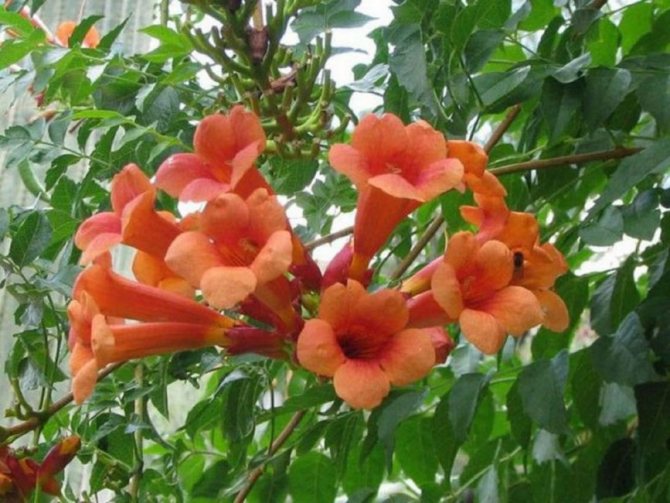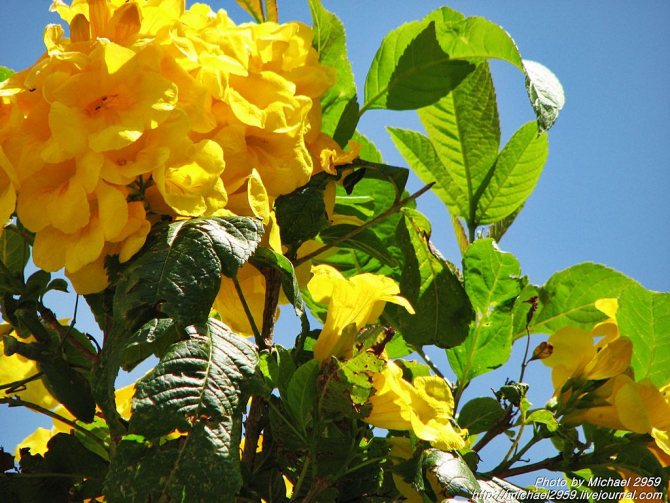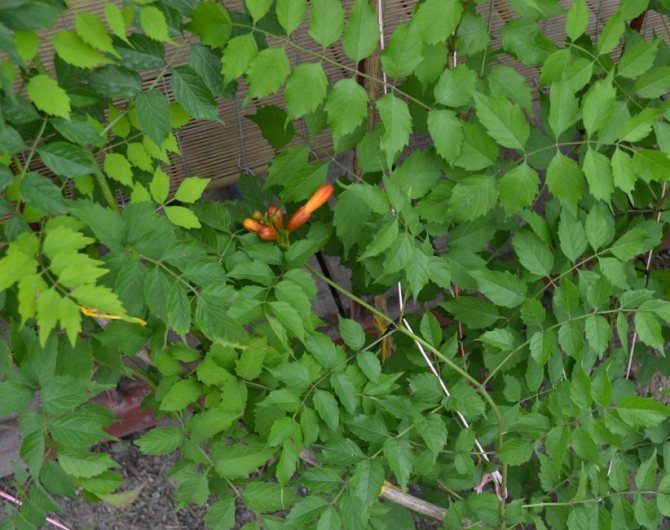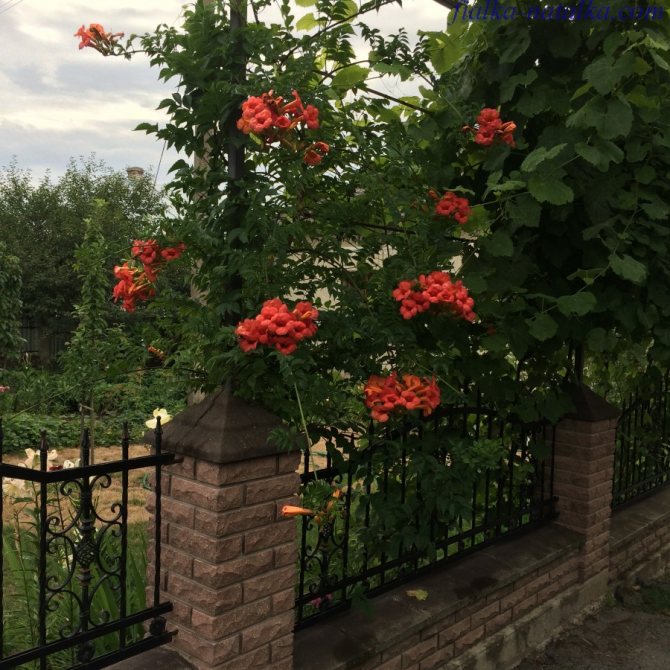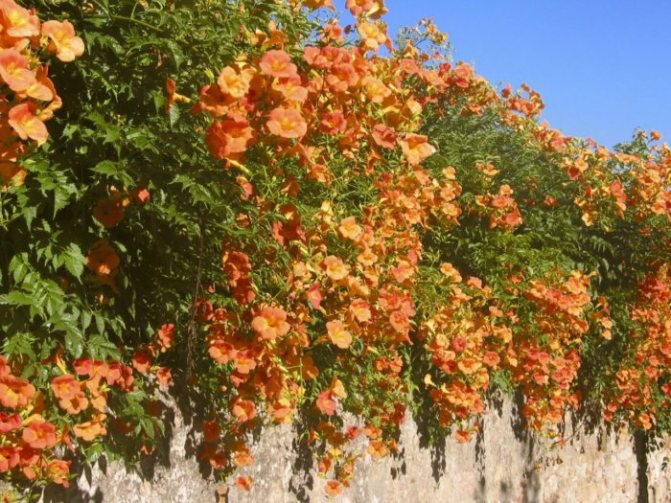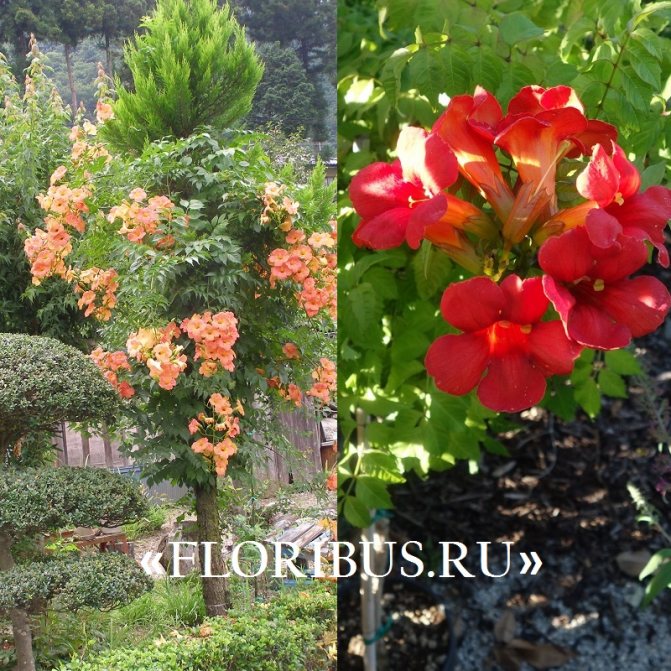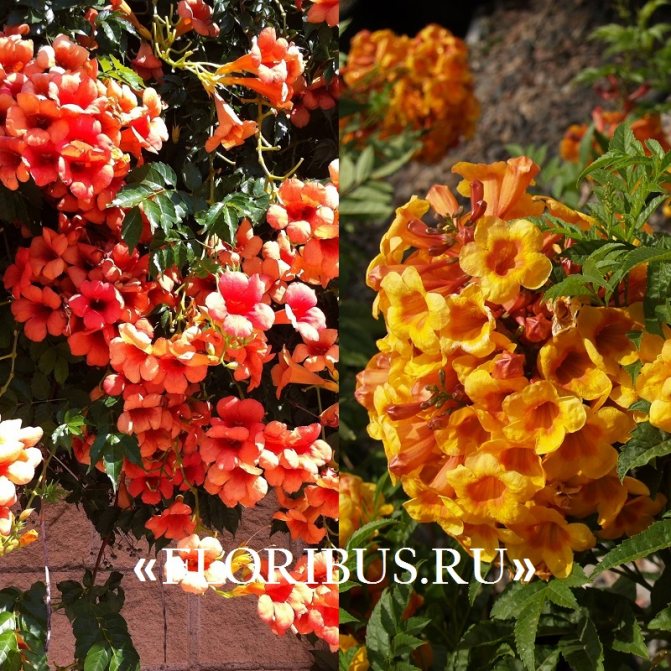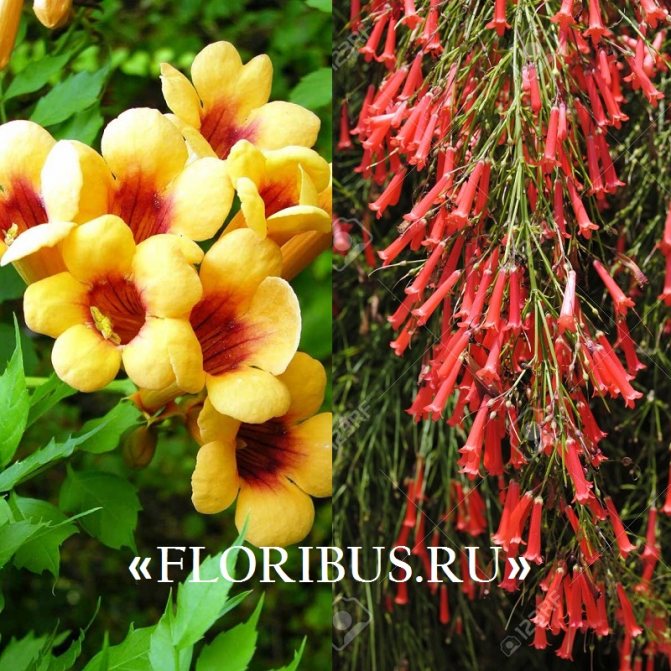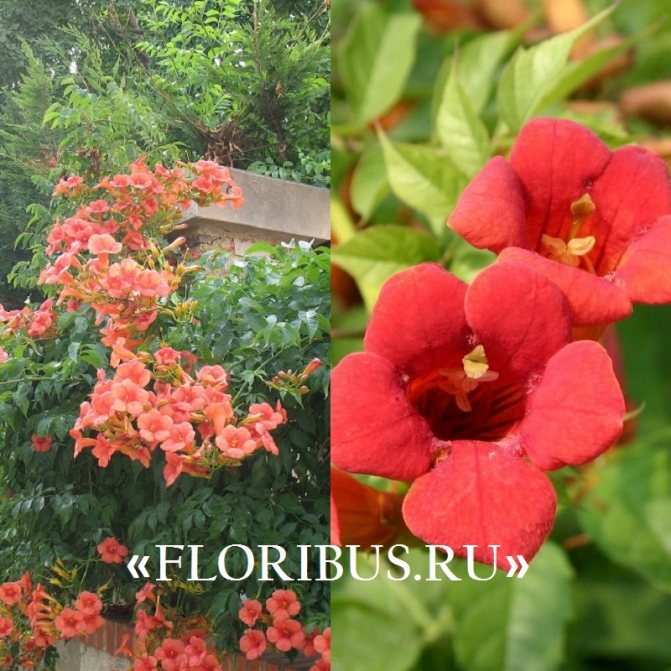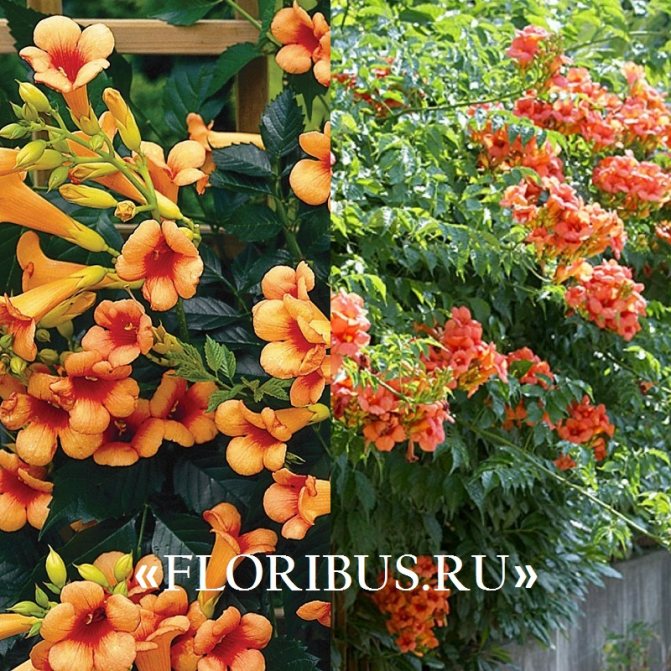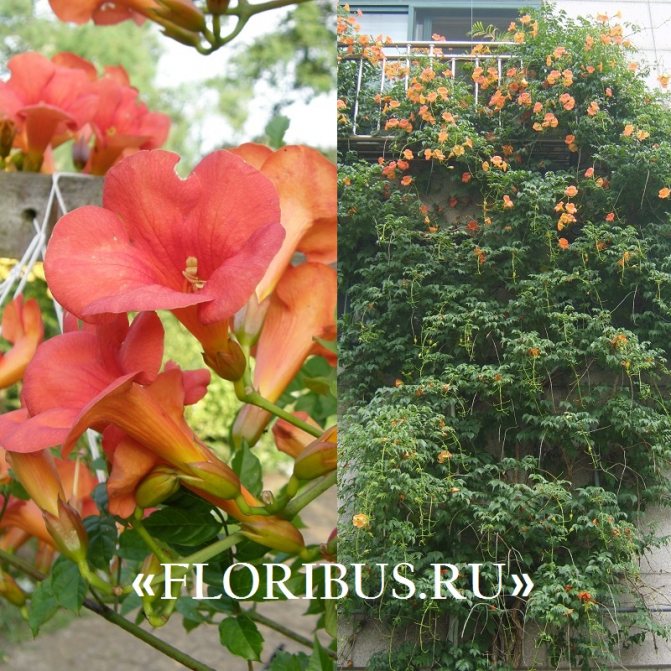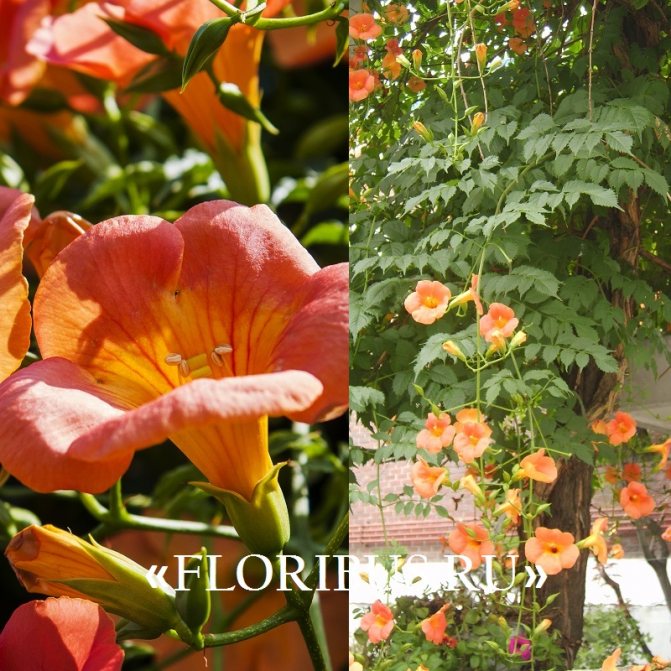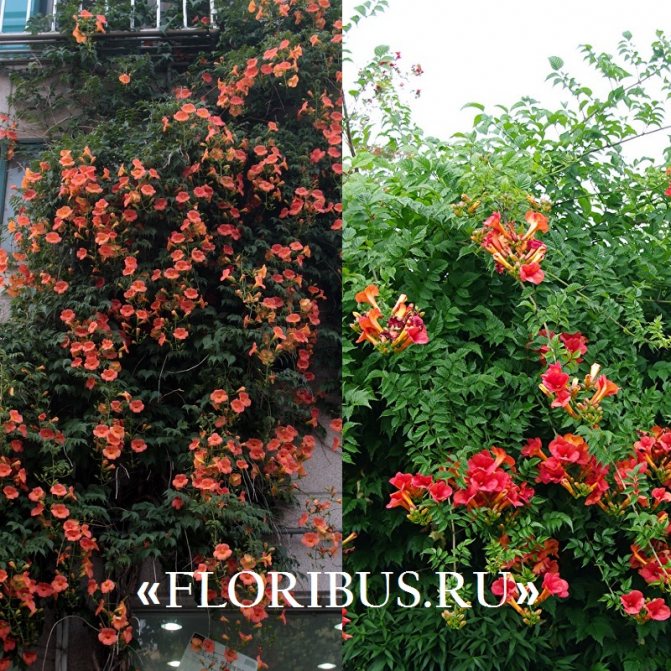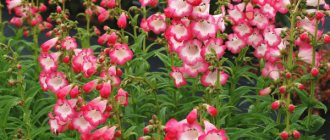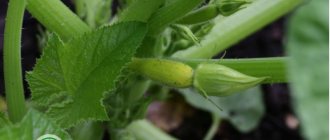Luxurious greenery with clusters of bright orange flowers, twisting gazebos, fences, arches in southern cities - this is Kampsis, a spectacular plant that amazes everyone who sees it for the first time with its beauty. It is not surprising that many summer residents and owners of their own houses want to grow kampsis on their site, decorating them with different corners of the garden. Perhaps it is worth getting to know the catchy exotic better and learn all the nuances of its content.
Campsis (lat.Campsis) is a whole genus of deciduous vines that belong to the vast family of Bignoniaceae (lat.Bignoniaceae). Other members of the family (radermacher, jacaranda, chylopsis) also have a creeping liana-like morphology, however, among more than 850 species, there are trees, shrubs, and even ordinary grasses. The genus Kampsis has several separate popular species, which, due to their characteristics (relative unpretentiousness, pleasant appearance and exceptional tenacity), are very often grown in gardens for decorative purposes and are used to solve landscape design problems.

It should be noted that the name of the southern liana comes from the Greek word translated as "bent", "twisted", and some gardeners call kampsis tekoma. From a botanical point of view, this is not true, since tekoma is a separate species of plants from the same family. The common popular name of Kampsis - trumpeter or pipe flower - is associated with the shape of the plant's flowers, which resemble a wind instrument.
The geography of the origin of the plant is extensive. The homeland of some species is the Far East, including China, others were first described in North America. Today, Kampsis is widespread throughout the world, however, its gravitation towards southern latitudes is noted, since the warm climate allows the plant to show itself in all its tropical beauty. However, with proper care and certain conditions, it is possible to grow Kampsis in the Moscow region and in other regions of the middle latitudes. It should be noted that the plant is perennial and does not need an annual transplant.
In general, Kampsis is a climbing creeping plant with abundant foliage and large bright flowers, collected in panicles. Vine leaves are pinnate, compound, with an odd (from 5 to 11) number of leaves. Inflorescences - rich orange and red, less often - yellow or pink. The shape of the flowers is tubular, delicate petals expand towards the top and form a crown. Liana bears fruit in smooth dicotyledonous pods, each of which contains several porous seeds. Pod fruiting makes them easier to harvest.
[!] During the growing season, buds, flowers, and leguminous fruits can be seen simultaneously on the shoots of Kampsis.
Consider the main types of campsis common in gardening, and popular varieties derived from them.
Description
Campsis is also called bignonia, tekoma, tekomaria. This is a liana, a large perennial deciduous gritting plant of the Bignoniev family.
On vertical supports, the vine is fixed with air roots, the length of the branches reaches 15 m. The leaves are pinnate, with jagged edges (see photo). The flowers are large (up to 9 cm long, 5 cm in diameter), tubular, collected in panicles.Shades of petals, depending on the variety, are bright orange, red, crimson.
Liana begins to bloom in June, and ends in autumn, in September. Beautiful fragrant flowers attract many insects, so the bushes are planted away from the windows of living quarters. The fruit of Kampsis is a leathery pod.
The homeland of vines is considered to be China and North America. The plant was brought to Europe in the 17th century and began to be actively cultivated. In Russia, tekoma spread in the middle zone and southern regions, because it does not tolerate severe winters, preferring a mild climate.
In landscape design, Kampsis is used to decorate high arches, hedges, and gazebos. Vine shoots are able to stay even on the vertical wall of the house, sprout between bricks, and cling to masonry. Florists use flowers for compositions, bouquets stand well in vases without losing their decorative effect within 1-2 weeks.


Campsis - wondrous liana
Campsis is also called "tube flower" or "tekoma". This is a tree-like perennial deciduous liana, which can rise to a height of 15 m along a high trellis.


Campsis can "disguise" any fence or even a building in a summer cottage
The shoots of the plant have the peculiarity of spiraling around the support. As they grow older and woody, they resemble the trunks of fancy fairytale trees. Young shoots have juicy green leaves and paniculate inflorescences, collected from large bright orange or scarlet tubular flowers, reminiscent of gramophone. The plant blooms all summer: from June to September.
Two types of plants are known:
- rooting campsis - originally from North America;


Rooting campsis
- large-flowered campsis - naturally grows in China.
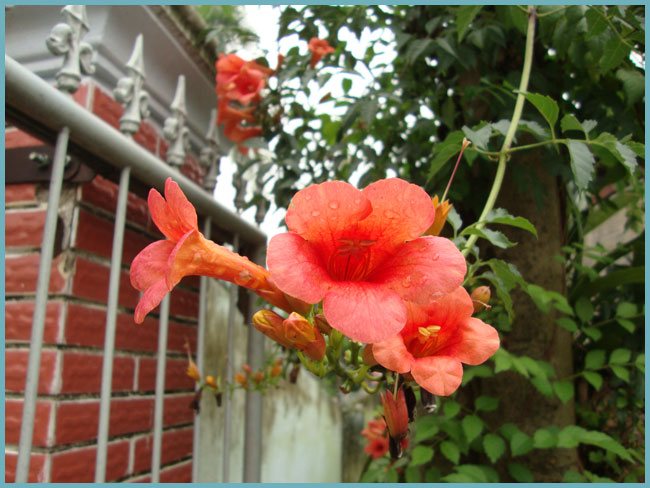

Large-flowered campsis
Types, varieties
The genus of the plant consists of 3 species. Rooting campsis is the most popular, the most common varieties are:
- Flava - flowers of a pale yellow hue;
- Early - flowering begins in early summer;
- Dark purple - liana with large dark red flowers;
- Flamenco - the flowers are bright red, the length of the branches is up to 5 m.
Hybrid campsis (Tagliabuan) was recently bred, the species is distinguished by increased frost resistance, easily overwinters without shelter at -10 ° C. One of its varieties - Madame Galen - is very decorative, with spreading lush branches and orange flowers (see photo).
Chinese (large-flowered) kampsis is distinguished by warmth, increased flexibility of vines and the absence of aerial roots. The shoots of this species are small, the flowers are fiery orange. The plant does not tolerate frost, even with a short-term drop in temperature to -18 ° C, the bushes will freeze.
Varieties
The small genus includes 3 main species, and 3 ornamental plant varieties. Taking root kampsis is widespread in Russia. The plant develops large roots in internodes, clinging to all possible surfaces. Shoots reach 8 m in length. The petiole includes 9-11 leaf blades with insignificant pubescence on the reverse side. The size of the flowers is up to 6 cm, they are collected in a brush at the top of the shoot. The orange tube gradually turns red in the stipule area. The variety is frost-resistant and tolerates a short-term drop in temperature to -20, but prefers a warm climate, therefore, in the fall, it requires protection from the gardener.
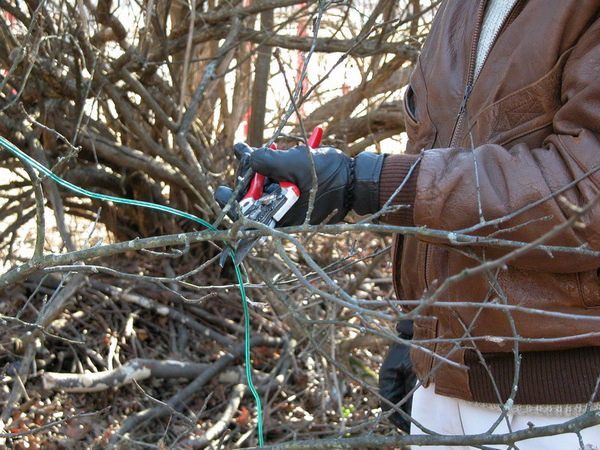

You may be interested in:
How to care for jasmine in the fall, preparation for wintering: pruning, preparation features Each garden culture has its own characteristics of care, including jasmine. This shrub is also called mock-orange, ... Read more ...
This type includes varieties:
- Flava;
- Early;
- Flamenco.
They differ in the duration of flowering and the period of bud dissolution.
The large-flowered Chinese variety is presented as a liana that does not have aerial roots. It is related to lianas in appearance due to the fact that it attaches to supports and surfaces due to processes.On the petiole there are 7-8 paired leaves up to 6 cm long, the edge is completely absent. The flowers have a narrow tube, the length is no more than 8 cm, they are colored orange. The shoots are small in comparison with the rooting species. It tolerates a short-term drop in temperature to -18 degrees, but prefers a warm winter.
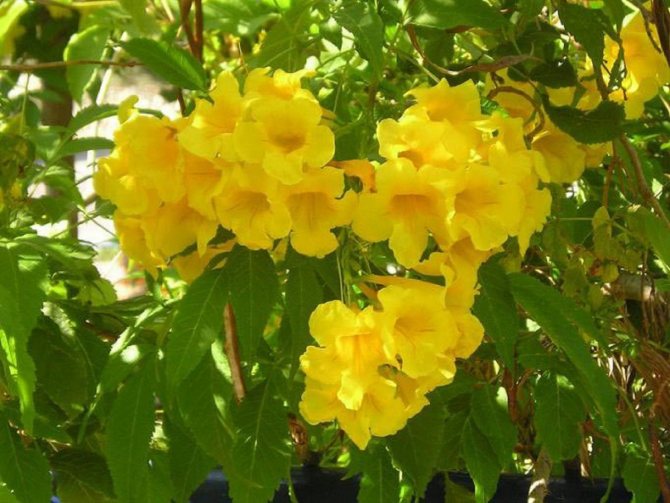

Hybrid - a young plant variety with large flowers and flexible vines, reaching no more than 6 m in length. In Russia, the Madame Galen variety is often grown. It is a sweeping bush with large orange-red flowers. This variety is used for gardening summer cottages, because it is the most unpretentious, it tolerates frost well.
Choice of place and conditions of detention


Liana grows well, capturing territories like a weed. But in order for the bushes not to lose their decorative effect and bloom magnificently, it is required to follow the rules for planting and care.
Lighting and location
Campsis loves sunny, warm areas. It is good if the sun's rays in the second half of the day will scatter high, but thin tree crowns. The base of the liana is shaded with a stunted shrub.
Open areas of the garden are a suitable place for a vine, which will decorate with lush vines any structure installed for zoning the site. An unpretentious culture grows well and develops in the shade, but for abundant flowering, the bushes require good lighting.
Temperature
Tekoma loves a warm, mild climate. Spring growth begins when frosts and nighttime temperature drops stop, and the air warms up to + 20 ° C. The most comfortable temperature of the summer season is + 25 ° C. The plant tolerates hot days well.
Before frosts in central Russia, the vine is laid on the ground, removed from the supports and covered. Without insulation, the plant will freeze.
Air and humidity
Campsis is not capricious and does not require spraying the leaves, special air humidification. Drafts are undesirable, strong gusts break young shoots. Therefore, when choosing a site, take into account the protection of the place from the wind by bushes, trees, buildings.
Priming
Tekoma bushes are completely unpretentious to the composition of the soil. Liana grows equally well both on fertile lands and on sandy, calcareous areas. The main condition is that moisture should not stagnate in the soil. Therefore, in lowlands and flooded places, drainage must be laid under the soil layer.
Conditions of existence
The Kampsis genus is represented by several varieties:
Small sprout of Campsis
- Campsis chinese
- Taglibuan campsis
- Rooting campsis
- Large-flowered campsis
Only a rooting species tolerates short-term frosts. Rooting campsis has winter hardiness up to - 20 ° С. The rest of the species are capable of blooming in southern countries, where the air temperature does not drop to negative values.
Flamenco is one of the most hardy varieties, but in order for it to grow magnificently and delight with its flowers, it is necessary to create some conditions. Flamenco campsis - what planting and care it needs:
Secure location. The best place for rooting kampsis is not far from the southern wall of the house.
The ability of the roots of this to destroy the foundations of buildings is much less than that of its wild relative, but it is still better to plant the plant a little further from the buildings.
In some estates, buildings are arranged in a circle. A certain isolated zone is created, where the temperature drop is not so noticeable. Also here the plant is protected from the winds.
The courtyard can be decorated with a pergola with beautiful Flamenco flowers or a campis grown in the form of a standard tree.
Abundance of the sun. A native of southern countries, the rooting Kampsis is very fond of the sun. The place of its existence should be illuminated throughout the day.
Fertile soil. On poor rocky or sandy soils, the plant will not bloom.Campsis requires fertile soil with a high organic content. To do this, when planting, a hole is dug, larger than the root system of the seedling.
About two buckets of humus are introduced into it, that is, rotted manure or compost.
Throughout its life, the plant needs annual organic feeding.
Regular watering. Campsis is not very picky about soil moisture and can easily tolerate a short-term drought. Much worse for him is the constant waterlogging near the roots and trunk.
Watering should be regular, but not excessive. For a two-year-old plant, it is enough to provide watering once a week, depending on weather conditions. From watering to watering, the soil surface near the plant must dry out to a depth of about 7 cm.
Drainage. Drainage will help to avoid stagnant moisture at the roots of the plant. When landing on the bottom of the pit, fine gravel, crushed stone or expanded clay is poured with a layer of at least 15 cm.
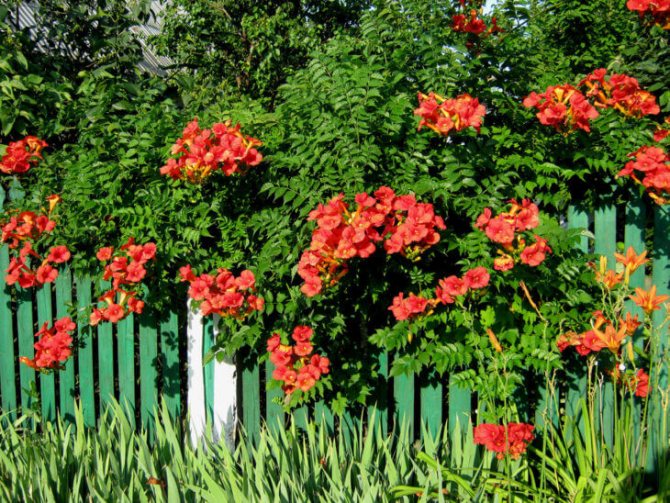

Fence decoration with creepers
In the absence of these materials, you can use coarse clean sand without clay or broken brick.
Neutral acidity of the soil. It is not recommended to plant Kampsis next to conifers, as they have different soil requirements. The needles make the soil acidic, which is not acceptable for kampsis.
Shelter for the winter. This procedure is necessary in areas with cold winters. It is important that the plant does not get wet under cover.
Campsis Flamenco blooms on the shoots of the current year, so it is better to keep the roots from freezing not on the branches. For this, a wooden box with ventilation holes can be installed above the roots for the winter.
Before installation, the box is filled with dry foliage or cut marigolds and chrysanthemums. Other plants can be carriers of diseases, and pests and diseases are almost never on these flowers. In addition, chrysanthemum leaves and flowers have a scent that repels mice.
Pruning. After rooting, under favorable conditions, the plant begins to quickly gain weight. If the growth space for it is limited, then it is necessary to resort to formative pruning.
Several of the strongest shoots remain as the main ones. It is they who will make up the future skeleton of the plant, and the rest are removed completely.
In areas with warm winters, the plant does not require shelter, so the branches of the vine remain on the support.
After a dormant period, the plant starts growing again and new shoots are formed from the main branches, on which flowers are formed.
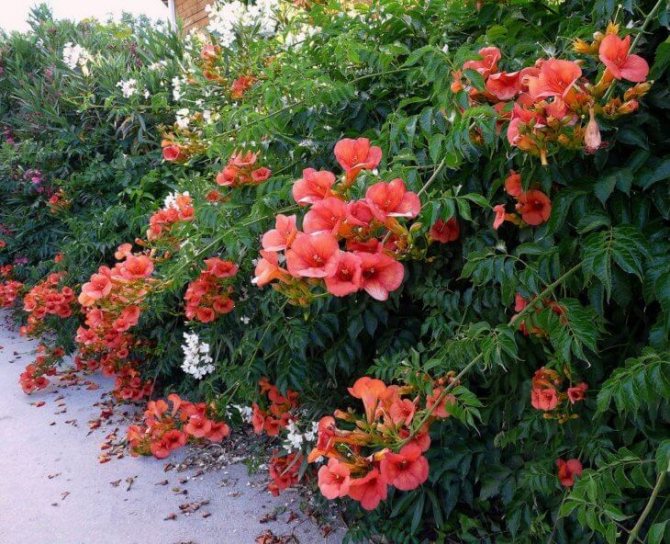

Lush bloom of Kampsis in the garden
Where the campsis needs to be covered for the winter, it is good to use plant supports that can be laid on the ground along with the lignified stems.
This option makes autumn gardening easier. The lattice is simply lowered down, and the branches are covered with lutrasil or agrotex non-woven fabric.
In the absence of mobile supports, the campsis is cut off before the onset of frost 30 cm from the ground.
The Flamenco bloom is so beautiful that caring for it and overcoming difficulties is nothing compared to these huge caps of flowers.
When to plant campis in central Russia
In the suburbs, liana is planted when the earth warms up and the threat of frost disappears. Usually this is the second half of May.
Preparation
Pits for seedlings are prepared in the fall. The dimensions of the holes are 50x60x50 cm. A drainage layer is poured at the bottom - gravel, expanded clay, 15-20 cm high.On top of the hill, the earth is dumped, a layer of fertile garden soil is mixed with compost (5 kg) and phosphorus-potassium fertilizers (0.5 kg).
Planting process
Seedlings are selected healthy, without damage and signs of disease. Procedure:
- The seedling is placed vertically on top of the earthen slide.
- Straighten the roots.
- Cover the roots with soil.
- Consolidates the soil at the trunk.
- Watering.
The space near the trunk is mulched, peat or compost is used.If the vine is not intended to decorate an arch, wall of a building or a fence, a trellis is installed next to the young plant.
Outdoor care for campsis
In care, an exotic liana is unpretentious, for all its non-capriciousness, it is characterized by rapid growth, it easily recovers even after frost damage.
Watering
Watering requires balance: avoid prolonged drought or stagnant water. Liana is quite drought-resistant and can tolerate short-term overdrying of an earthen coma, but it is better to water it in a timely manner. To maintain moisture, you can plant bushes of stunted plants with similar care requirements in the near-stem circle.
Top dressing
Liana grows well without feeding, but will respond with abundant flowering throughout the season to the application of nitrogen-phosphorus fertilization.
Pruning bignonia
Pruning is necessary regularly, but only in areas with mild winters and warm summers. In regions with prolonged cold weather, pruning will lead to a lack of flowering.
The formation of the bush should begin immediately after planting: cut off the shoots at a height of 15 cm from the ground surface. When they grow a little, you should leave 4-5 of the strongest, and remove the rest. As they grow, the remaining shoots should be guided along the support, if necessary, tie them up. The liana will fully form in 2-3 years (skeletal branches will reach a length of about 4 m).
Lateral shoots must be shortened every spring to 2-3 eyes. Remove dry, weak, poorly growing shoots completely. If one of the skeletal branches is severely damaged, it is necessary to remove it, and send the strongest shoot to the place of its growth. To rejuvenate the vine, it is necessary to drastically cut it, leaving a length of 30 cm above the soil surface. The procedure is carried out before the awakening of the kidneys (in early spring).
For longer flowering, it is necessary to remove wilted buds throughout the season and cut off faded shoots by 3-4 eyes.
Reproduction methods
The current is grown from seeds, but this method is inconvenient for a long waiting period - the plant will bloom only after 7 years. Liana is propagated vegetatively using cuttings, root shoots and layering.
Seeds
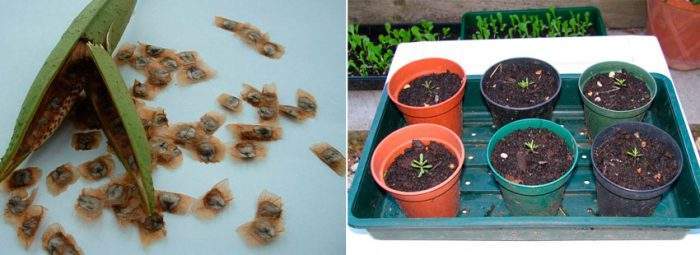

The seed does not require soaking and heat treatment. The seeds are planted in a container with loose nutrient soil, deepening by 0.5 cm. The boxes are placed in a warm place, maintain a temperature of + 25 ° C, you can cover with foil or glass, but then you need to ventilate daily.
When sprouts appear in a month, the container is placed on a sunny windowsill and opened. Water the plants as needed, avoiding stagnant water. Seedlings with 5-6 true leaves are planted in open ground.
Cuttings
In the spring, lignified annual branches are used for cutting cuttings. In summer, the middle part of green young shoots is used. The lower leaves are removed on them, 2-3 upper leaves are left, shortened by 2/3 parts. The cuts are rubbed with charcoal and the cuttings are immediately planted in the soil at an inclination of 45 °.
Root shoots
With the help of a shovel, they dig out and cut off a piece of root, from which young shoots have sprouted and transplanted to a new place. The main condition is to carry out the procedure when the plant is at rest - in the fall after shedding the leaves or in early spring.
Layers
In the spring, young shoots that have appeared at the roots are bent to the ground and fixed. The place of contact with the ground is covered with soil and watered regularly. By the fall, the shoot will take root, in the spring the young liana is dug up and transplanted.
Landing Kampsis
In order for Kampsis to reveal itself in all its glory, it needs a lot of warmth and light, so it is advisable to choose places well-lit by the sun for planting.
Tekoma can grow on any soil, but for a beautiful and abundant flowering, it needs a fertile and loose soil with a slightly acidic or neutral reaction, since a lean and dry one will not give the plant the necessary strength for full development.Therefore, if the land on the site is not nutritious, then already in the fall it is necessary to prepare a place for spring planting.
To do this, you need to dig a hole with a diameter of about 50 cm and a depth of 55-60 cm, add half a bucket of humus and 0.5 liters of complex mineral fertilizer to the extracted soil, mix everything. For drainage, it is advisable to pour fine gravel, expanded clay or sand on the bottom of the pit, pour soil on top with a slide and leave until spring.
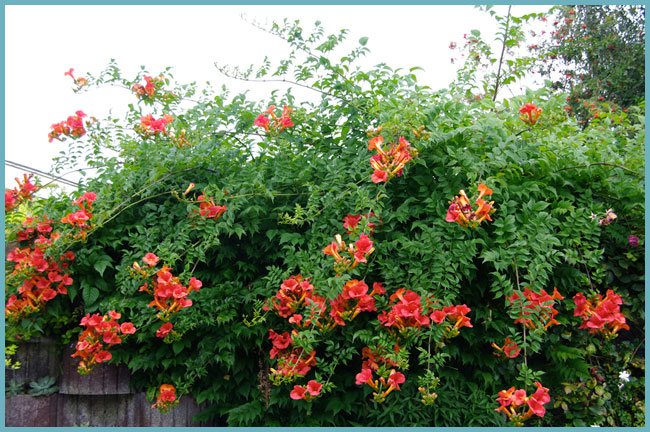

If you want to plant several plants, then plant them so that they do not interfere with each other.
In early April, when the threat of frost has passed, seedlings with buds that have hatched can already be planted in open ground. To do this, the seedling must be lowered into the hole, carefully spread the roots, covered with earth and lightly tamped. Then pour and mulch in a circle with peat.
If the soil is quite suitable, then Kampsis is planted in the spring directly in the open ground. To do this, you need to dig a hole 2 times larger than the root system of a young plant. Then deepen it into the hole, sprinkle well with earth, tamp and water generously.
Important! In advance, you need to provide a support along which the vine will curl.
Growing features


Tekoma is very resistant to diseases, and aphids can attack from pests in dry summers. Parasites damage young leaves and buds, and sugary insect secretions attract ants. Infected bushes are sprayed with solutions of Iskra, Tanarek, Aktara, Fitoverm preparations.
Of the diseases, Kampsis most often affects the rotting of the root system. The infection appears due to stagnant water in the soil. The affected areas are removed, and the irrigation regime is changed.
When planting a tekku, they take into account its peculiarity to grow rapidly and seize neighboring plots of land. Therefore, they limit the area around the perimeter, digging metal sheets around the landings to a depth of at least 80 cm.
Campsis, another name for bignonia, refers to leaf-shedding, woody vines from the bignone family. The name, most likely of Greek origin, translates to bend, twist, bend - this is how the stems of the plant look. The tekoma shrub looks like a kampsis, but it belongs to a different family, however, they can be distinguished only after studying special literature.
Used in vertical gardening. The leaves consist of 7-11 leaflets with saw-like edges.


Flowers are odorless, large tubular, painted in various colors: crimson, red, orange, pink and red-gold. The fruit of Kampsis is a pod 8-12 cm long, inside which seeds with wings ripen. When ripe, the fruits open, and the seeds are carried by gusts of wind.
Pests and diseases
Campsis is very resistant to diseases and is practically not exposed to pests. The only thing that can bother him is aphids, which sometimes grow in flower buds or in leaves located at the tips of young shoots. It is quite easy to get rid of aphids by sprinkling the affected areas with vodka from a spray bottle. You can simply give the plant a shower to wash off the aphids with a stream of water.
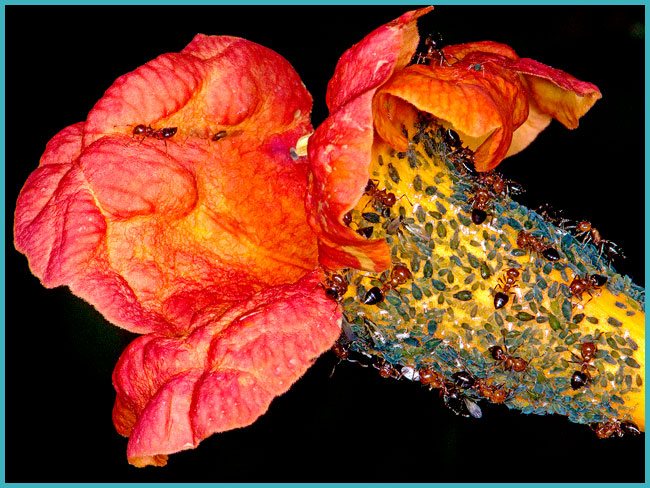

Aphids on a Kampsis flower
These are the simple, but very important rules for caring for Kampsis. But time will not be spent in vain caring for the plant: after all, it will turn into joy - every day all summer long to look at the wonderful bright beauty of the overseas liana.
Campsis in the garden: video
Types of kampsis: photo
The choice of planting material and popular varieties
There are two types of kampsis - rooting and large-flowered.
Rooting and hybrid, obtained by crossing the rooting and large-flowered species, are suitable for growing in the Moscow region.
Already in the first year, you can get offspring, so you should not purchase a lot of planting material.
When choosing seedlings, you should avoid buying plants with signs of diseases: fungal infection, spots on the shoots. Dried roots can slow growth.
Bushes are planted no closer than 4-5 meters from each other - based on the estimated planting area, young seedlings are acquired. The survival rate is 90%, so there is no need to buy with a margin.
Popular varieties of kampsis rooting:
- "Flamenco". Lianas up to 5 meters long, bloom from July to October, flowers are bright red.
- "Early", bright red flowers bloom from the beginning of June.
- Flava. The flowering period is July-October. The buds are light yellow.
Liana Kampsis hybrid reaches a length of 5-7 meters. It tolerates frost well. Appearance - a bush with a lush crown, sometimes winds along the trellis. Popular variety "Madame Galen" with bright orange flowers.
Campsis rooting Flamenco varieties - description of the plant
Under natural conditions, rooting campsis grows well and reproduces on the shores of the Gulf of Mexico in the countries of South America in a warm and mild climate.
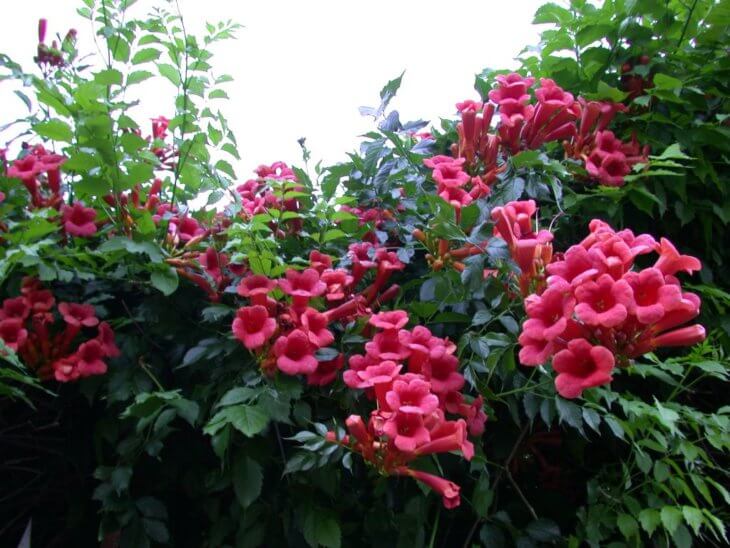

Lat. Campsis
Under natural conditions of existence, it is a powerful vine with thick lignified stems.
Its height or length, according to reviews, can reach 18 meters or more. The roots of this plant are powerful and can damage even very thick concrete surfaces and buildings.
For cultivation in gardens, varieties have been bred that do not occupy the territory so aggressively.
Leaves are light green in oval-pointed shape with teeth along the edge of the leaf. They are located on a long petiole of seven or more pieces.
The flowers of the plant, according to reviews and descriptions, have a tubular shape, which at the end opens with several large petals. It is because of these luxurious flowers that Kampsis is grown. They are collected in large brushes and are located throughout the plant with bright accents.
There are only two varieties of rooting garden kampsis:
Flamenco. Bright purple large flowers up to 8 cm long adorn the liana from early July to late October. The height of the vine can reach a maximum length of about five meters.
Elava. Smaller yellow flowers than the previous variety, bloom from late July to late September. Plant height 3-4 meters.
Depending on the conditions of existence and the climate in which the kampsis grows, the flowering time and the size of the vine itself may vary.
The plant got its name due to its ability to bend, as the Greek word "kamptein" means "to bend" or "twist".
There are growths or air roots on the stems of the plant, with the help of which the vine is fixed on the support and rises higher.
In the initial stage of growth, campsis requires a garter to a support. Then, having finally rooted, the plant is able to climb the support itself.
The spectacular Flamenco flowers make gardeners grow liana, despite some difficulties.
Landing place
For planting kampsis, a place is taken from the southern, southeastern side of the house, it must be protected from gusts of wind.
Attention! You should not place the plant near windows - many insects flock to bright flowers, dense foliage serves as a shelter for them from the sun's rays and wind. All these animals will be in the house.
Germination of new roots into any materials (wood, brick, concrete) is the second reason to place it away from buildings. After three to four years, the roots of Kampsis completely destroy the wooden window frames.
Campsis takes up a lot of space, so it is not planted next to other shrubs. The overgrown crown gives a shadow. It is planted in a place where it cannot interfere with neighboring crops.
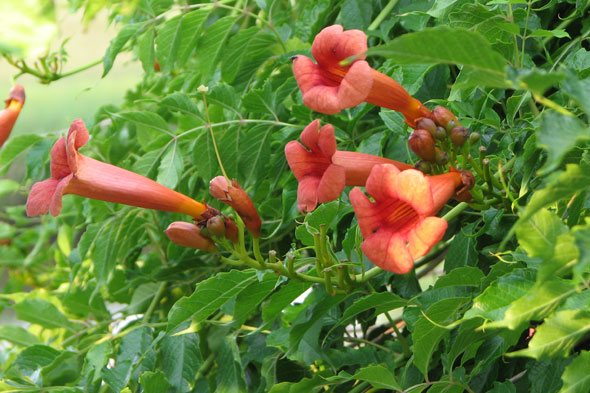

A good option for planting in a flowerbed, fenced on all sides with asphalt - this will prevent the plant from seizing the surrounding area.
The use of kampsis in landscape design
Planting a campsis to decorate the landscape of a country house is an excellent solution.Liana is fast-growing, has a strong stem, which in five-year-old plants is similar to the trunk of a small tree.
Attention!
The Kampsis vine is like a grape vine, but the gardener is more pleased with the flowering. The advantage is that the flowers stay on the liana for a very long time, and new buds are formed until autumn.
Since many varieties of the plant have aerial roots, it clings to all kinds of structures, creating a green hedge. In landscape design, it is used for landscaping gazebos and other structures.
The plant is suitable for people who do not want to spend a lot of time on caring. Fast growing vine, needs watering. Top dressing and shelter for the winter in some regions. It is rarely affected by pests and can tolerate drought.
Landing
Seedlings at the age of 2-3 years begin to be planted in the second half of May, when there is no risk of repeated frosts.
The roots are straightened, the tips are trimmed. The earth is added to the hole gradually so that all the voids are filled. After planting, the soil is lightly tamped and watered abundantly. Mulching with compost will reduce moisture evaporation. A support is installed for the seedling - the vine should not trail along the ground. It is advisable to dig metal sheets around the plant, at a distance of 1 meter, to a depth of 0.8 m - they will prevent the "spreading" of the root system.
Flamenco
Rooting campsis Flamenco is a very showy, fast-growing plant with orange-red tubular flowers and abundant foliage. It takes root on its own and clings to the support with countless aerial roots. Leaves are bright green, odd-pinnate, long, consisting of 9 elements. On the reverse side - light green.
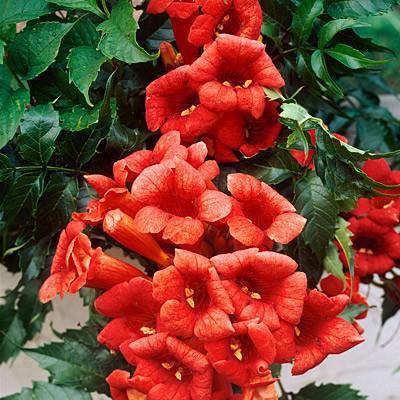

Liana propagates by seeds, layering and root parts. Bush formation and pruning is easy.
Liana prefers sunny places, sheltered from the wind. Undemanding to watering, drought-resistant. It grows on any soil. And on fertile soil and when feeding with nitrogen-phosphorus fertilizers, it grows and blooms profusely for a longer time.
Rooting campsis Flamenco, whose winter hardiness is low (it normally hibernates at a temperature of about -6 degrees), it also withstands frosts down to -20 for a short time. True, in the winter it needs shelter. After winter, weak and diseased shoots are removed.
Reproduction
Campsis reproduces easily by any means:
- seeds;
- green and lignified cuttings;
- young root shoots;
- layering.
Growing from seeds
Seeds are sown in early spring in light, loose soil. Planting depth 5 mm. Germination temperature 25 ° С. Seedlings will appear in a month. With the appearance of 3 pairs of true leaves, the seedlings are transplanted into open ground to a permanent place. The seeds do not require pre-treatment and preparation.
Important! Campsis grown from seeds rarely inherits varietal properties, so the method is rarely used for reproduction.
Growing from cuttings
The middle part of green shoots in the middle of summer is cut into cuttings 20-30 cm long, leaving two pairs of leaves. To reduce evaporation of moisture, the leaves are cut in half. Planting material treated with a root formation stimulator is planted at an angle of 45 ° in the prepared soil. The composition of the soil is light, loose. After abundant watering, the soil is mulched.
Reproduction by lignified last year's cuttings is carried out in early spring, planting them in the ground, observing an inclination of 45 °.
The survival rate of green and last year's cuttings is 90%.
Growing from root shoots
In the fertile, moist soil of the Kampsis, roots grow actively, giving shoots. The ascended bushes are dug out, leaving part of the root. Without shaking off the remnants of the earth, they are transplanted to the chosen place.
Important! Reproduction by layering is carried out in the spring before the start of sap flow or in the fall, after the end of the growing season and the shedding of leaves.
Reproduction by layering
A live, frost-free shoot is bent down in early spring and sprinkled with earth. During the summer, the soil at the planting site is moistened and loosened. The rooted shoot is transplanted in the spring of next year.
Advice! The bark of the shoot in the place to be sprinkled is cut with a sharp knife in the longitudinal direction. The procedure stimulates the emergence of new roots.
Plant care is within the power of a novice gardener. Agrotechnical techniques for growing:
Watering vines is carried out as the soil dries up.
For the plant to survive, there is enough water that has fallen out with precipitation, but drought will impede vegetative growth, flowering will not be abundant. Stagnation of water also negatively affects - roots begin to rot. It is better to water in the morning when the temperature of the air and water does not make much difference.
Weeding is combined with loosening the soil. A newly planted plant requires weeding. An adult campis does not need careful care.
The fertilization schedule is standard for flowering plants.
If the soil has been prepared in advance, there will be enough nutrients for 2-3 years of growth. After that, in the spring, nitrogen fertilizers are applied for the vegetative growth of young shoots. With the beginning of the laying of buds, it is advisable to add potassium and phosphorus-containing dressings - this will increase the number of blossoming flowers.
Supports for plants
Immediately after planting the cutting in open ground, you need to think about creating a good support for it. The plant needs to be tied up regularly. It is better if the support is removable, because the plant is characterized by rapid growth and the formation of tight, massive lashes. For the support device, dense wire or tight ropes are used. They can be placed in a ladder, or change shape depending on the landscape.
A removable support is needed, because for the winter the plant will have to be laid in a shelter with it. Veranda grates, a house fence or a gazebo are often used as support.
The support is more often the arch created on the personal plot. The green corridor in the form of an arch, stretching from the gate of the house to the gazebo, looks beneficial. This will require several metal rods, which are bent in the shape of an arch and placed at a distance of up to 0.5 m from each other. Kampsis is planted near each rod on both sides. If the planting was carried out at the end of spring, then by the end of summer the plants completely weave supports. The difficulty in this case lies only in the shelter for the winter.


Preparing for winter
An adult plant can withstand frosts down to -20 ° C. Kampsis requires shelter only in areas with prolonged frosts.
The bushes removed from the support are sprinkled with a layer of leaves, spruce branches, sawdust. To prevent wetting, it is advisable to cover the top with a layer of waterproof material, for example, plastic wrap.
Using simple techniques, gardeners successfully grow ornamental plants on their site, pleasing the eye with bright colors during most of the warm season.
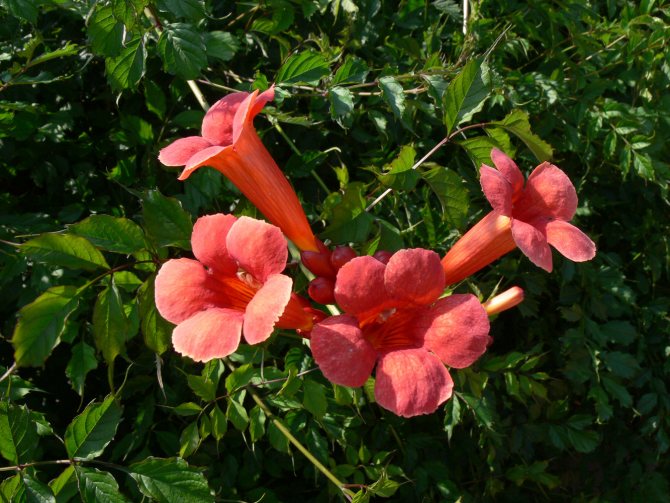

Campsis, aka tekoma or bignonia, is a perennial garden plant, a deciduous woody liana of the Bignonia family.
Campsis, aka tekoma or bignonia, is a perennial garden plant, a deciduous woody liana of the Bignonia family. It has good frost resistance, it has taken root in the middle zone of our country, in particular, in the Moscow region.
Bending liana trunks and extraordinary flowers in the form of phonographs give the plant an extraordinary decorative effect. Gardeners loved it for its ease of care and cultivation.
Important! Planting and reproduction has its own subtleties, which must be clarified in advance.
Campsis rooting Flamenco varieties - diseases, pests and growing problems
Campsis Flamenco has a fairly good immunity, and therefore, it is affected by diseases mainly as a result of improper care.So, if you plant a kampsis rooting in a lowland, where dampness is often present and cold drafts are present, the plant's immunity may deteriorate, which will make the culture vulnerable to infections. The most common problem of the described flower is stagnation of moisture at the rhizome. So that this does not happen, it is important not only to lay a drainage layer on the bottom of the planting hole, but also to make the soil moisture and breathable directly. This measure is especially important on dense and heavy soils. Before planting rooting campsis, we recommend digging up the selected area with the addition of sand, humus, peat and old sawdust. Also, it is important to add ash or dolomite flour at the same time, because acidic soil often becomes one of the factors that contributes to the development of putrefactive and fungal diseases. In case of overflow, you can gently loosen the soil near the flower. This will speed up the drying of the earth. You can also scatter ashes under the bush. This agent has fungicidal properties, and also accelerates the drying of the soil. If the flooding was constant, the rhizome may begin to rot. For plants in open ground, you need to let the soil dry, and then water it several times with a fungicidal preparation. It is better to choose a remedy that is suitable specifically for root lesions. You can apply Fitosporin or Magnicur. For specimens that grow in pots, a transplant can be carried out. In the process, the affected roots are removed to healthy tissue, the cut sites are treated with cinnamon or crushed activated carbon, planted in clean disinfected soil and a new pot. In the next few waterings, we recommend using a manganese or boric acid solution. Rooting Kampsis is rarely attacked by pests, but sometimes aphids appear on the flower. This insect is dangerous not only because it feeds on plant juices, it also spreads viral diseases. For protection, it is important to maintain cleanliness under the bushes, remove weeds. Also, it is important that there are no anthills near vulnerable crops. Otherwise, these insects will spread aphids around the garden, and any measures will only be temporary. If the population is small, you can spray the plant with a boric acid solution. It will also be a good foliar dressing, which will improve flowering. In case of serious injury, we recommend using Aktara or Actellic preparations. To prevent the development of fungus and the appearance of pests, we recommend in early spring and when the garden is preparing for wintering in autumn, spray the plants and the soil near them with Bordeaux mixture.
While watching the video, you will learn about growing vines.
All the disadvantages of a plant like Campis Flamenco outweigh the very big plus of the spectacular flowering.
Attention super FLY!
Vines
Interesting to read:
- Tunbergia flowers: conditions for good flowering, application in landscape design
- Growing kvamoklite cirrus cypress liana: expert advice
- Perennial geranium: features of care and cultivation
- Terry calendula: a variety of shades, maintenance rules
- Cyclamen seed reproduction: variety selection, sowing secrets and keeping conditions
- Liriope: what kind of flower is it and how to care for it
- Hibiscus hibiscus: plant features and growing conditions
- Decorative curly flowers for a summer residence
- Chubushnik Girandol: the nuances of care and pruning
Varieties and varieties of the garden plant Campsis
The genus of plants is not numerous, it includes only a few species of vines.


The genus of plants is not numerous, it includes only a few species of vines.
K. hybrid - perennial, a hybrid of rooting and large-flowered kampsis. It grows to a greater extent as a shrub, a little less often as a climbing liana. The leaves of the plant are complex, with large flowers. Frost resistant. It has been cultivated since the end of the 19th century.
K. large-flowered. Curly liana. Sometimes it grows like a shrub. It has odd-pinnate leaves.The flowers of the species are even larger than those of the rooting Kampsis. Flowering occurs no earlier than 2-3 years. A less frost-resistant species that can grow in frosts of at least -18 degrees. A popular variety of large-flowered kampsis is Thunberg.
K. rooting. The homeland of this perennial plant is North America. A large liana with a huge number of light roots, by means of which it is attached to vertical supports. It has odd-pinnate leaves, rather large (up to 0.2 m). The flowers are large with a tubular corolla. The opening of the buds does not occur immediately, but alternately, which makes it possible to enjoy the beauty of flowering throughout the summer period. Has a number of decorative types - "magnificent", "golden", "early" and "dark purple".
Flava
This is a perennial deciduous vine that can reach fifteen meters in height. What is interesting about this rooting campsis? Flava — a variety that was bred in 1842. Aerial roots growing on the stems of a large liana cling to the support and allow you to hold it. Leaves are large, pinnate, tubular flowers of golden yellow color, collected in large inflorescences.
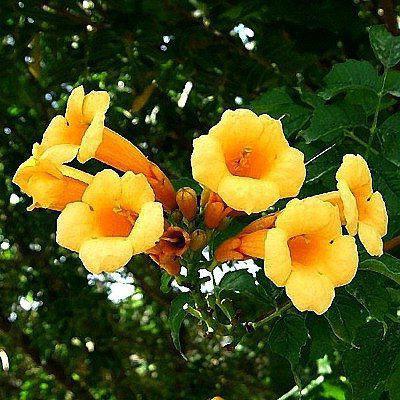

Liana prefers sunny, sheltered from the wind places and soil rich in nitrogen-phosphorus fertilizer. Looks good at various supports, fences, arbors, walls. Young shoots require a garter. The plant is trimmed, giving the desired shape.
In harsh winters, branches can freeze slightly, although the plant can withstand frost down to -20 degrees. At the end of the winter period, the old stems are removed.
Care Tips:
- For the first year, the vine is grown in containers; it hibernates in a cold cellar. They are planted in the ground in early spring before flowering. For the winter, young plants are covered with spruce branches.
- Prefers moderate watering without stagnant water.
- Reproduction is carried out by cuttings, layering and seeds. When propagated by seeds, they are sown in the ground in early May, the plant begins to bloom in the third year after planting.
- It tolerates pruning of shoots. In areas with a cold climate, pruning after winter is not recommended so that the plant blooms earlier.
- It does not suffer from any diseases, of the pests it affects only aphids.
Campsis planting and care in the Moscow region
Planting the plant is done in soil rich in minerals and trace elements. Limestone soil is also suitable for this purpose. Landing in the suburbs is allowed to be carried out in May. To do this, dig a larger hole, put a rhizome and bury it in the soil. Sprinkle compost over the roots and water them.
Despite the fact that Kampsis is a relatively frost-resistant perennial, preliminary measures for winter are mandatory. Liana is removed from the support and laid on the ground. Then sprinkle with spruce branches, and lay a plastic wrap on top of it.
On a note! During the period of growth and flowering, bignonia must be watered with nitrogen and phosphorus-containing fertilizers.
Then the plant will delight you with its own flowering a little longer.
In hot weather, with poor watering or abuse of fertilizers, aphids may appear. You should fight with it with special chemical agents or spray the culture with a substance of laundry soap.
We form the crown by pruning
It is better to prune the campsis for uniform formation in the fall, before the onset of frost. Gardeners act according to the scheme:
- From a young plant, 3 fully formed, mature shoots are selected, and the rest are removed with pruning shears in the fall.
- To form the crown of the plant, the branches during the growing season are tied to a support and directed in the right direction.
- This process is repeated for 4-5 years in a row until a massive vine is formed.
- During the growing season, faded flowers are removed in a timely manner and the branches are shortened by 10 cm.
Anti-aging pruning involves removing 60% of the branches.
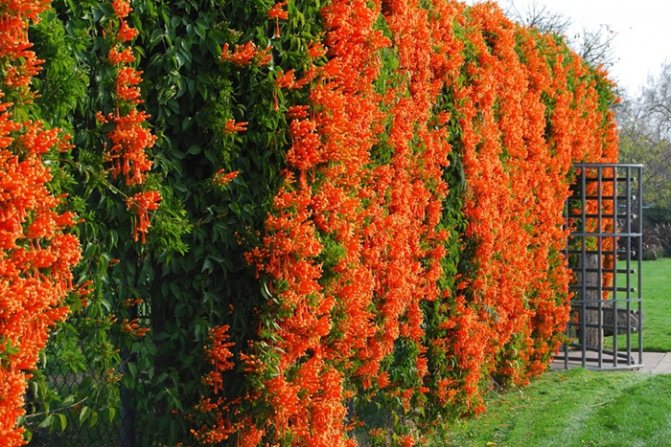

The main breeding methods of Campsis:
- Cuttings
- Growing from seeds
- Planting root shoots
The first and last option is the most well-known. Propagation by cuttings is a common and effective way. At the beginning of summer, a cutting is taken and planted in a shady space. Meanwhile, the soil must be mulched so that moisture remains longer.


Propagation by cuttings is a common and effective way.
Seed propagation is not a well-known method. The seeds are planted in separate containers in March and watered occasionally. In a month, the first shoots will appear. When the seedlings have a certain number of leaves, and the frost stops, Kampsis is planted in the soil.
Another breeding option, the most simple and very effective, is the planting of kampsis rhizomes, which often grow near adult species. The shoot is transplanted with the root system until the Kampsis has entered the period of functional growth.
Why Kampsis does not bloom
Cold climate, strong drafts, late frosts in spring, pest infestation are possible reasons for the lack of flowering of bignonia. It is worth noting that the flowering of Kampsis grown from seeds should be expected in the 4-6th year after the emergence of seedlings. Rooted cuttings bloom in the 3rd year.
If bignonia is grown in cold regions, it should not be pruned: the vine easily tolerates it, but does not have time to form flower buds. Therefore, if your city has a rather cold climate, it is absolutely impossible to cut the campis.
Propagation of Kampsis by basal processes and layering


Reproduction of kampsis by root suckers photo
In the fall (after the leaves have fallen off) or in the spring, you can plant the basal processes. Dig it up along with a part of the root and plant it in a place of constant growth.
Spread by layering in the spring. A shoot growing close to the soil surface must be bent down, sprinkled with earth. Maintain soil moisture at the ditch, periodically loosen the surface. Separate the cuttings from the mother plant next spring. Plant in a permanent place of growth, water well.
Campsis propagation by cuttings
To propagate the plant by cuttings, they must be cut from the middle of the shoots. This is done so that a couple of leaves remain, which are shortened by 2/3. After that, the material is planted on a bed in a shaded place at an angle of 45 °. After planting, the site is watered and covered with mulch.
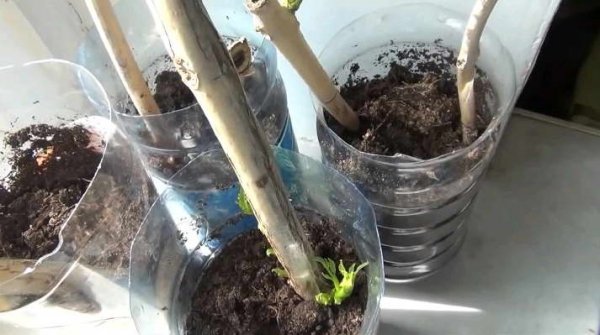

The cuttings root quite well, the survival rate is almost 100%.
Do-it-yourself support for liana kampsis, master class
Trellis is one excellent support option for creepers kampsis. It is convenient in that it is suitable for almost all types of climbing plants, it is easy to do with your own hands, it is convenient to carry and install it in any corner of the site, and also, having treated it with special substances, will last more than one year.
For support you will need:
- thin slats
- screwdriver
- self-tapping screws
- hacksaw
- miter box
- paint or varnish
First, we knock down the support frame, the sides of which we fasten with self-tapping screws. We put the slats vertically on the support at a certain distance from each other.
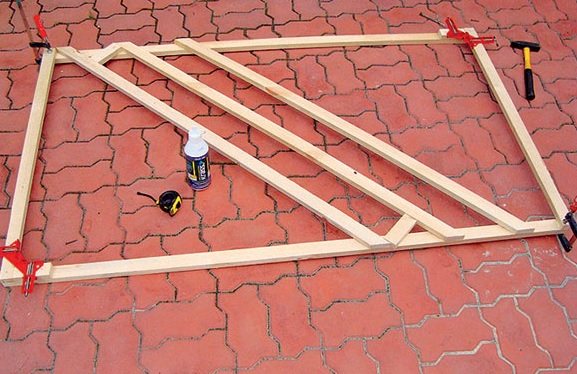

We turn the frame over and on the back side we stuff the slats along the contour of the frame at an angle of 45 ° so that rhombuses are obtained.


We fasten the diagonal slats with self-tapping screws for stability.


The height of the trellis can be very diverse, it all depends on the plant itself. Trellises with a number of different heights look very harmonious.
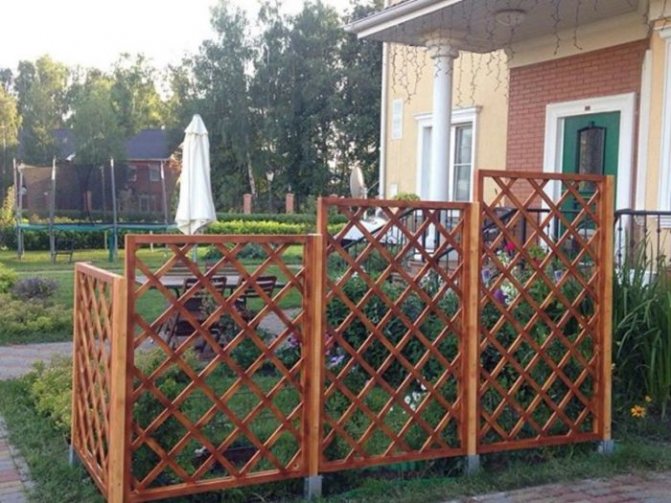

Just do not forget to cover the support with paint or varnish, these means will save the tree from decay, and the invention itself will delight you for more than one season.
Pruning Kampsis
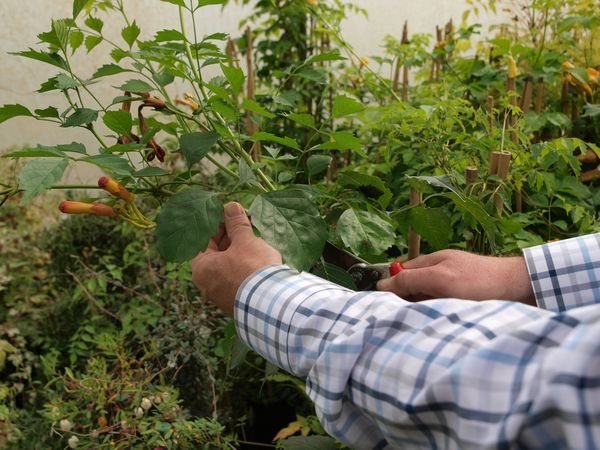

- Pruning of campsis is carried out in early spring before the start of the active growing season.
- First of all, all damaged and diseased shoots are removed.
- Pruning should be started immediately after planting a young plant. In this case, the shoot is shortened to a height of 15 cm.
- Then, after the appearance of a large number of shoots, leave 5-6 of the largest and strongest, and remove the rest.The rest must be directed to the support - these will be the skeletal shoots of your vine.
- Each year it is necessary to cut the side shoots into about 2 buds.
- If you want to rejuvenate the vine, you must trim all the shoots to a height of about 30 cm.
- Throughout the season, it is recommended to remove faded buds and cut off the shoots with them. This will prolong the overall flowering of the vine.
Campsis photo
Campsis is a perennial plant that will make the perfect hedge around your garden, as well as a great addition to any color arrangement.
Regional features
In the regions of Russia, liana kampsis usually takes root without problems. Gardeners highlight several regional features that are important to consider before planting.
Moscow suburbs
With proper care, shelter for the winter, the vine will live for more than a dozen years. The Moscow region is considered an ideal place for her breeding.
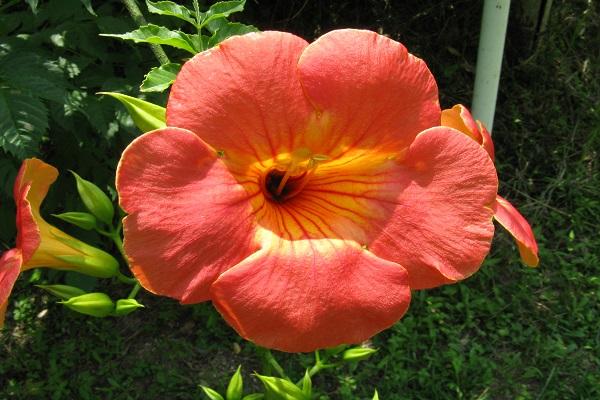

Ural
In the Urals, cold winters prevail, the air temperature often starts below -40. This is an unfavorable region for growing lianas. Better to plant it in a winter garden, greenhouse. On the street, it is unlikely to take root.
Middle latitudes
The culture will bloom profusely with proper care. With prolonged frosts -25 or more, it is worth covering the plant. If this is not done, the bush will not bloom, lose immunity, or freeze.
Side effects of beauty
Due to the profusely blooming crown, the campsis is used as a hedge. As a concealer for arches, arbors and walls. Care should be taken when landing Kampsis under the window. Firstly, the plant is melliferous, then the abundance of insects entering the house through the window is guaranteed. Secondly, the vine, the owner of tenacious roots, climbing the brick walls, penetrates the brickwork itself, causing damage.
But as a decoration for garden and park areas - it is out of competition.
A small botanical description of the genus
Among all small horticultural crops, Kampsis is quite impressive in size. Representatives of all three species reach an average of 5 to 10 meters. At the same time, the plant easily and quickly develops as a cover soil, and is fastened with air layers or roots for a support.
Before proceeding to a detailed description of the large-flowered or rooting campsis, let's first look at a small general botanical description of the entire genus and some photos. This is necessary, since recently you can see a lot of new hybrids, breeders present them to gardeners as separate plant species. Therefore, in order not to accidentally make a mistake and not get confused when choosing a seedling or seeds, it is worth knowing some general information.
The history of the name of the vine
A funny story awaits even with regard to the title. In general, it comes from the Greek language, from which the word "kamptien" literally translates as "bend" or "cling". It is clear that it is directly related to the ability of woody liana to reach several meters in height due to the adhesion of shoots or aerial roots to the support.
Some gardeners call Kampsis Torenia, but it is worth knowing that this is a completely different plant, close in genus. It may seem that they are identical at first glance, but nevertheless, botanists are recognized to consider them completely different in their botanical description. You can compare them with each other in the photo below.
Stems, leaves and bright flowers
Stems of deciduous perennial liana kampsis are long and flexible, can reach, already in the second year of life, 5 meters. The seasonal growth of the plant is from 1 to 4 meters, but this depends on the climate in the region, as well as the illumination and duration of the warm season. Over time, the shoots woody.
The leaves are pinnate, on one petiole there are from 7 to 11 small leaves with a serrated edge, as can be seen in the photo below.
The main decorative role in Kampsis is played by bright flowers with a shade from fiery orange to salmon yellow. From the middle of summer, you can observe abundant flowering, during which tubular funnel-shaped buds with 5 lobes bent perpendicularly are formed. Most flowers have no smell, but there is a lot of nectar, which should be taken into account when collecting them for cutting. The flower sap attracts a large number of insects that pollinate the plant. Tubular buds with a bright corolla are collected in apical inflorescences in the form of small loose panicles.
Fruit ripening usually occurs during the period from the beginning of autumn. By the end of September and until the first days of November, you can see single pods-pods, inside which are collected a lot of seeds with a translucent wing. After the fruit ripens, the wind carries them throughout the site.
Campsis support, photo
Initially, Kampsis needs support, and young plants also need tying. The walls of houses, gazebos, fences can serve as a support for the vines:
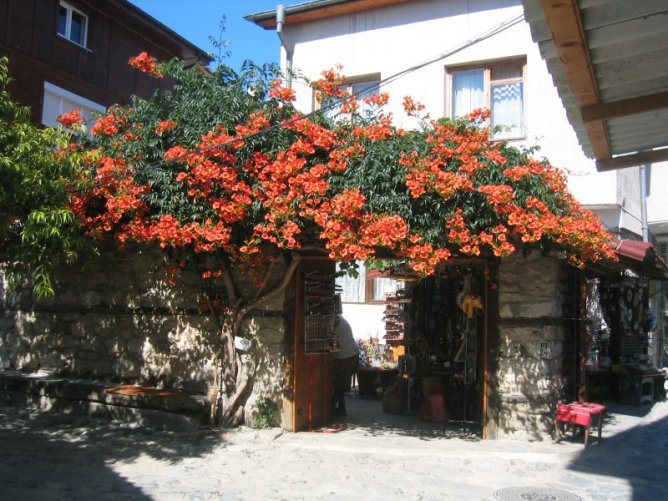

as well as purchased and / or home-made structures made of metal and wood:
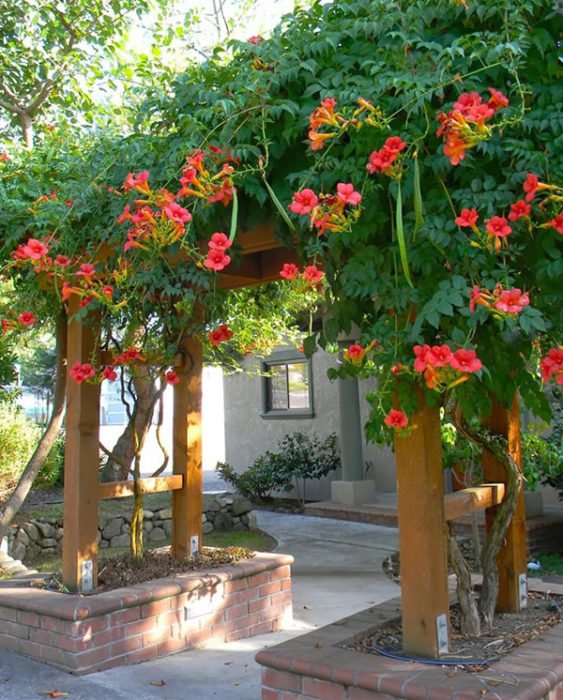

Growing campsis from seeds


Capsis seeds photo
Seed and vegetative (by cuttings, layering, root shoots) reproduction is possible.
The lack of seed reproduction is the loss of varietal characteristics (if the seeds are collected from hybrid forms), the flowering of a new plant occurs after 4-6 years of life. But there is enough planting material. Store the seeds at room temperature until spring; no pre-treatment is required before sowing.


Campsis from seeds photo
- Take a box with loose, breathable neutral soil, the seeding depth is about 5 mm, the distance between the seeds is 2-3 cm.
- Cover crops with foil. Maintain the air temperature at 25º C, ventilate the greenhouse regularly and water through the drip tray. Expect seedlings to emerge in a month, and then remove the shelter.
- With the appearance of three true leaves, transplant the young plants in separate containers.
- Plant hardened plants in open ground from the second half of May.
Features of Kampsis
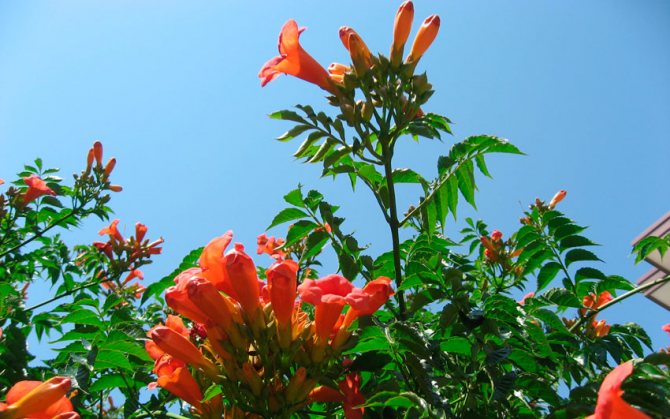

This vine is often used for vertical gardening. The fact is that she is able to cling to and hold on to the support with her aerial roots. Unpaired complex leaf plates include from 7 to 11 leaflets, which have a serrated edge. These leaves look very impressive. Tubular flowers are large and have no aroma at all. They are part of the short paniculate inflorescences located at the ends of the stems, while such flowers reach 9 centimeters in length, and their diameter is 5 centimeters. The color of the flowers depends on the variety and can be crimson, pink, orange-red or golden-red.
The plant begins to bloom in June and ends in September. This vine is considered a honey plant, and it is able to gather around itself not only bees, but also ants, wasps and flies. The fruit is a leathery elongated pod that reaches 8 to 10 centimeters in length. Such a pod consists of 2 valves, while inside it there are many membranous seeds with wings. The ripe fruit cracks, and many seeds fly out of it, which are able to fly far enough. But you should be aware that not all Kampsis have seeds. It is believed that for this it is necessary that a vine of another clone be in the immediate vicinity.
Growing
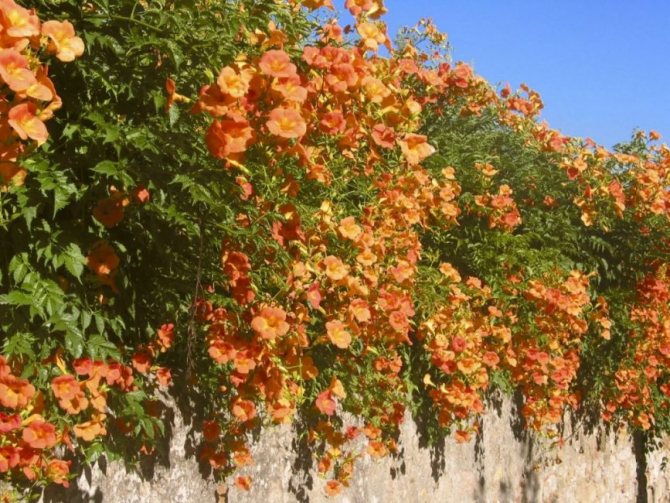

Campsis is an unpretentious plant
In terms of unpretentiousness, endurance and resilience, Kampsis, perhaps, has no equal... Even novice florists can safely undertake the cultivation of this plant.
As the owners of the garden plots on which this perennial vine grows, in part it can even be called aggressive due to its numerous and fast-growing root shoots.
back to menu ↑
See also: Cypress is a graceful plant that is good for health.Description of 10 varieties suitable for growing at home, care and reproduction (50 Photos & Videos) + Reviews
Temperature


Campsis belongs to heat-loving plants.
Campsis can withstand temperatures as low as -20-25 ° C in winter. Despite such frost resistance, this vigorous liana belongs to heat-loving plants. It is the thermophilic nature that prevents the widespread distribution of this plant, which grows beautifully and blooms luxuriantly in mild climates.
In colder conditions, the vine can also be grown, but in this case it will need to provide shelter for the winter. In regions with too low winter temperatures and harsh weather conditions, Kampsis is not cultivated.
back to menu ↑
See also: How to make gabions from a grid with your own hands: we turn a summer cottage into a cozy corner, decorated with a designer taste | 120+ Photos & Videos
The soil
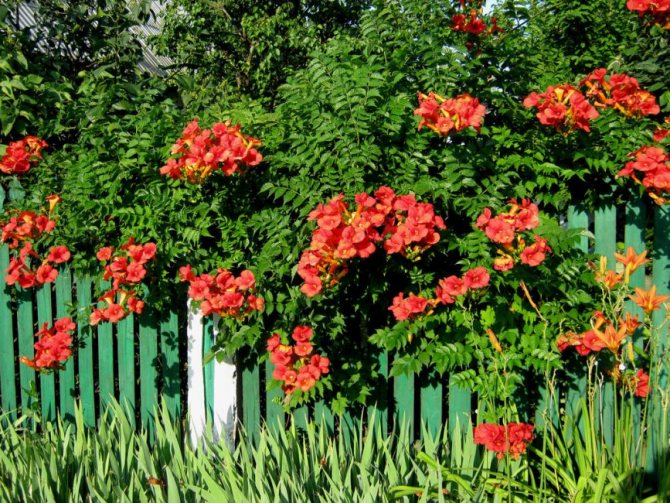

The plant has no special requirement for soil.
The plant is unpretentious and has no special requirements for soils. It can grow even on heavy loams, but still responds well to fertile soil, such as humus.
It is desirable that the soil on the site is not acidic and too wet. Excessive moisture can cause root rot to develop.
back to menu ↑
See also: Gazebos with barbecue and barbecue - (80+ PHOTOS) Drawings of projects that you can implement yourself
Watering
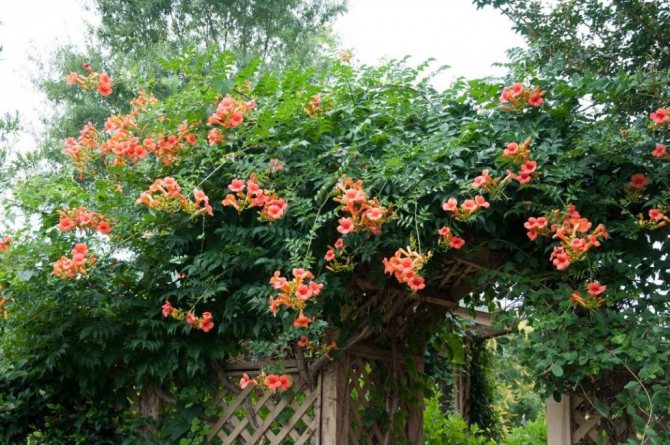

Adult Kampsis easily tolerates drought
»
- in the first two decades of May, plants are watered with an interval of 3-4 days
- from the end of May to the first half of June - with an interval of 5 days
- in the second half of June and July - once a week
[/ wpsm_list]
During the hot summer months, the frequency of watering should be left unchanged, and the water rate should be increased. At the same time, it is necessary to avoid waterlogging and stagnation of water, as this can lead to negative consequences for the campus.
Between waterings, the plant responds well to a refreshing "shower" from spray nozzles with fine sprays in the morning or evening. As a rule, starting in August, regular watering is stopped, however, if the weather remains warm during the autumn months, they should be done occasionally.
» ]
back to menu ↑
See also: Garden jasmine: description, types, planting in open ground, care, pruning, reproduction (60+ Photos & Videos) + Reviews
Loosening, mulching and weeding
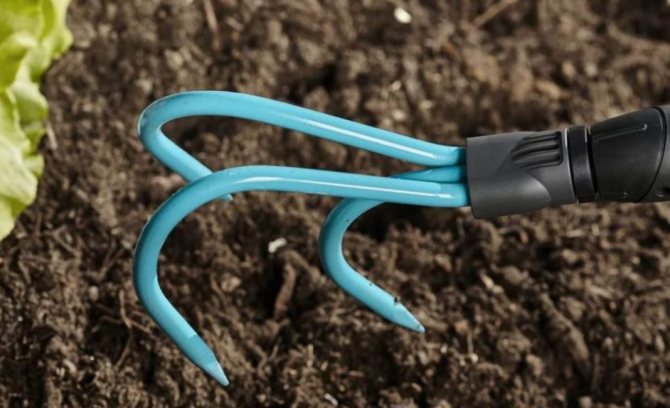

Loosening the soil should be regular
It must be remembered that watering leads to soil compaction. For this reason, plants require regular loosening of the soil. It promotes better air penetration to actively growing roots. Weeds should be removed periodically during the growing season.
Mulching not only protects the root system from overheating and improves aeration, but also helps to retain moisture in the soil. This makes it possible to water the Kampsis less often, without deteriorating the supply of moisture to the plants. You can plant several low-growing perennials at the trunk of the vine. They will shade the roots and cover the exposed parts of the shoots.
Care
Rooting campsis easily tolerates drought, but it is better to water it regularly, without waterlogging the soil.
The plant does not need to be fed if it is planted in well-fertilized soil. Otherwise, nitrogen and phosphorus fertilizers are introduced into it, which ensure lush flowering during the summer season.


To regulate growth, tekoma pruning should be done constantly. It grows quickly, flowers appear only on new shoots, so all old branches should be removed.
Pruning is carried out in the autumn after the end of flowering or in the spring, until the buds swell:
- several strong young shoots are left at the plant, all the rest are removed;
- long branches of a young liana must be tied to a trellis, forming a plant;
- the plant should be given a certain shape for the first four years, until the shoots are stiff.
After pruning, the bush should have ossified shoots and three to four young branches, which are shortened to three buds.
If the main trunk is damaged, it is removed, replacing it with new shoots.
To rejuvenate the plant, all shoots are periodically pruned, leaving them up to 30 cm tall.
In the summer, the bush can be given any shape, create compositions using various designs. Campsis will not suffer from this.
Watering Kampsis
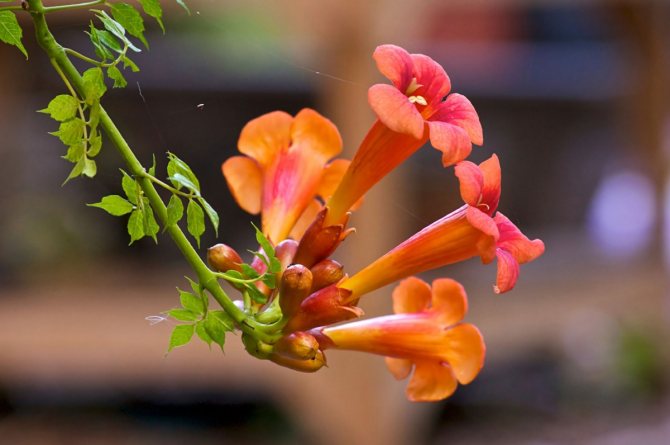

Campsis does not tolerate excessive moisture, but it is also difficult to tolerate arid soil. Therefore, it is important to strictly observe this balance - it is necessary to water regularly, but in moderation. The frequency of watering can be increased during the dry season, but do not overdo it. You can heavily flood the roots of the plant, from which the Kampsis will die. At the same time, do not delay watering for a long time - the decorativeness of your vine depends on them.
Cutting Kampsis
Green cuttings should be prepared in June or July, with only the middle part of the stem being taken. All leaves should be removed from them except the upper 2-3, which will need to be shortened by 2/3. It is necessary to make a bed in a shaded place and plant a cutting there at an angle of 45 degrees. It should be borne in mind that the soil must be loose and fertile. The planted cuttings need to be watered, and the surface of the bed should be covered with a layer of mulch. On average, every ninth stalk out of 10 is rooted.
You can also use a lignified stalk for reproduction. They should be prepared at the beginning of the spring period, while lignified one-year-old shoots should be used. Cuttings are planted at an angle to a permanent place, because on average 10 cuttings out of 10 are rooted.
After flowering
Such a vine is quite frost-resistant. So, she can safely tolerate a drop in temperature to minus 20 degrees, but it should be short-lived. If the winter is long and frosty, then the plant will need shelter. In this regard, experts advise making removable supports for the Kampsis, so that they can be removed in autumn, and re-installed with the onset of spring. Such a plant is covered for wintering in almost the same way as grapes. The stems must be removed from the support and placed on the ground surface. Then they must be covered with a layer of dried foliage, sawdust or spruce branches. On this layer it is necessary to lay a film, which is again covered with spruce branches.
Types and varieties of Kampsis with photos and names
Campsis rooting Campsis radicans or bignonia rooting Bignonia radicans


Rooting campsis Campsis radicans cultivar Minnesota Red photo
Originally from North America. The length of the liana is about 15 cm. The pinnate leaves reach a length of 20 cm, consist of 9-11 leaf plates, are painted in bright green, the surface of the leaf plates is smooth, and pubescence passes along the veins on the reverse side. Tubular flowers 9 cm long are up to 5 cm in diameter, collected in 10-15 pieces. on the tops of the shoots. The corolla has a bright orange color, the limb is fiery red. Flowering starts in the middle of summer, the buds open sequentially. The fruit is a pod 5-12 cm long.
Subspecies of rooting Kampsis:
- Bignonia is magnificent - the liana curls weakly, more like a bush with thin long shoots. The leaf plate consists of small oval-shaped leaves. The flowers are red-orange in color.
- Bignonia golden - bright yellow flowers.
- Early bignonia - flowering occurs a month earlier than the species plant. The flowers are large, fiery red.
- Bignonia dark purple - large flowers are painted in dark red with a purple tinge.
Conditions for Campsis
In order for the liana to feel comfortable, it is necessary to create certain conditions for its life and development. These are, first of all, soil, sun, ambient temperature, care. Campsis is an unpretentious plant, but when good conditions are created, it gratefully responds with massive flowering and growth.
Place on the site
It should not be forgotten that despite adapting to cold temperatures, it is a southern plant. Therefore, the area on which the liana will grow must be sunny and protected from drafts. It is necessary to take into account the purpose for which the plant is planted and it is imperative to provide the liana with a place for weaving. This can be a fence, wall, pillars, special devices. Otherwise, it will creep along the ground, crawl through trees and bushes.
The soil
The plant grows absolutely calmly on any soil, even on scarce calcareous soils. But the result is important - the vine will not bloom on them. Here, after planting Campsis, he needs fertilizing, which is carried out with mineral fertilizers. Organic additives will help in this case. On good soils, the plant will actively grow and bloom without them.
Temperature
For central Russia, the winter hardiness of Kampsis is not high. The plant tolerates temperatures down to –20 degrees. without any shelter. Even if part of it is frozen, the plant will quickly recover. But under more severe conditions, it must be insulated without fail. The liana tolerates heat well, but watering should be daily.


